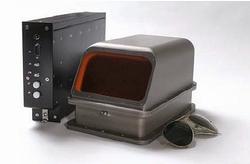Sun, Mar 02, 2003
 Max-Viz Inc. has been selected by a Boeing B767
operator to supply the EVS-2500 Enhanced Vision System for this
customer’s new aircraft. Max-Viz is developing a
radome-mounted installation of its EVS that will suit this aircraft
type with partners Nordam of Ft. Worth, TX and Associated Air
Center of Dallas, TX. The company anticipates system installation
in late 2003 with FAA certification in 2Q04.
Max-Viz Inc. has been selected by a Boeing B767
operator to supply the EVS-2500 Enhanced Vision System for this
customer’s new aircraft. Max-Viz is developing a
radome-mounted installation of its EVS that will suit this aircraft
type with partners Nordam of Ft. Worth, TX and Associated Air
Center of Dallas, TX. The company anticipates system installation
in late 2003 with FAA certification in 2Q04.
 The operator chose the Max-Viz system over
competing products due to its superior performance, much higher
reliability and smaller size. Another factor in their decision is
the belief that EVS will offer a significant safety advantage for
their international operations. This is the first application of
EVS on a commercial air transport category aircraft.
The operator chose the Max-Viz system over
competing products due to its superior performance, much higher
reliability and smaller size. Another factor in their decision is
the belief that EVS will offer a significant safety advantage for
their international operations. This is the first application of
EVS on a commercial air transport category aircraft.
The EVS systems developed by Max-Viz employ uncooled infrared
(IR) sensors to generate video-like images of the area in front of
an aircraft in flight and on the ground which can then be displayed
on any video-capable display in the cockpit or cabin. The systems
allow the pilot to autonomously ensure the safety of aircraft
operations during taxi, takeoff, approach and landing. IR images
can augment the normal visual scan when outside viewing is degraded
and is particularly effective at night, in smoke, haze and
smog.
 The EVS-2000 family of products is dual sensor
systems using a long-wave IR sensor (best for “seeing”
scene details) and a short-wave IR sensor (best for airport and
runway lights). The two sensor outputs are combined using a
patented process into a single image by a separate fusion
processor. The image on the B767 will be displayed on a cockpit MFD
that is video-capable.
The EVS-2000 family of products is dual sensor
systems using a long-wave IR sensor (best for “seeing”
scene details) and a short-wave IR sensor (best for airport and
runway lights). The two sensor outputs are combined using a
patented process into a single image by a separate fusion
processor. The image on the B767 will be displayed on a cockpit MFD
that is video-capable.
EVS technology is rapidly gaining recognition in the industry as
a key element in the prevention of CFIT and the early detection of
runway incursions. “We are very pleased to have been selected
by a sophisticated operator who recognizes the value of EVS and is
willing to take a leadership position in implementing it,”
commented Max-Viz President Gregg Fawkes. “This effort will
pave the way for EVS entry into the commercial air transport
marketplace.”
More News
Airport Marking Aids Markings used on runway and taxiway surfaces to identify a specific runway, a runway threshold, a centerline, a hold line, etc. A runway should be marked in ac>[...]
"It is extremely difficult, if not impossible, for manned aircraft to see a drone while conducting crop-enhancing and other aerial applications at low altitudes and high speeds. We>[...]
Aero Linx: The Skyhawk Association The Skyhawk Association is a non-profit organization founded by former Skyhawk Pilots which is open to anyone with an affinity for the A-4 Skyhaw>[...]
“The T-54A benefits from an active Beechcraft King Air assembly line in Wichita, Kansas, where all required METS avionics and interior modifications are installed on the line>[...]
Aero Linx: Aerostar Owners Association The Association offers the Aerostar Owner a unique opportunity to tap an invaluable source of information concerning the care and feeding of >[...]
 ANN's Daily Aero-Term (04.28.24): Airport Marking Aids
ANN's Daily Aero-Term (04.28.24): Airport Marking Aids Aero-News: Quote of the Day (04.28.24)
Aero-News: Quote of the Day (04.28.24) ANN's Daily Aero-Linx (04.28.24)
ANN's Daily Aero-Linx (04.28.24) Aero-News: Quote of the Day (04.29.24)
Aero-News: Quote of the Day (04.29.24) ANN's Daily Aero-Linx (04.29.24)
ANN's Daily Aero-Linx (04.29.24)





